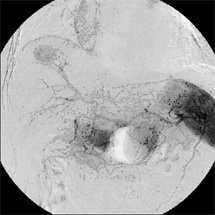 A new procedure, Y-90 microsphere radioembolization, is giving new hope in treating liver cancer, one of the most dangerous types of the disease, according to interventional radiologists at the Indiana University School of Medicine The new Y-90 microsphere radioembolization includes using a glass sphere containing yttrium-90 (Y-90), a radioactive element that produces radiation for a very small distance, so the radiation does not harm the nearby healthy tissues. The United States FDA has approved the procedure and it was applied for the first time in 2002. Interventional radiologists are interested in the Y-90 microsphere radioembolization as liver cancer treatment as the incidence of the disease is increasing due to hepatitis, obesity, and alcoholism.
A new procedure, Y-90 microsphere radioembolization, is giving new hope in treating liver cancer, one of the most dangerous types of the disease, according to interventional radiologists at the Indiana University School of Medicine The new Y-90 microsphere radioembolization includes using a glass sphere containing yttrium-90 (Y-90), a radioactive element that produces radiation for a very small distance, so the radiation does not harm the nearby healthy tissues. The United States FDA has approved the procedure and it was applied for the first time in 2002. Interventional radiologists are interested in the Y-90 microsphere radioembolization as liver cancer treatment as the incidence of the disease is increasing due to hepatitis, obesity, and alcoholism.
According to Daniel E. Wertman Jr., M.D., co-director of vascular and radiology" href="/tag/interventional-radiology.html">interventional radiology and assistant professor of clinical radiology at the Indiana University School of Medicine, around 300 liver cancer patients underwent treatment using Y-90 radioembolization after the beginning of the treatment program at Indiana University Hospital and the Indiana University Melvin and Bren Simon Cancer Center 3 years ago. Dr. Wertman commented “I’m really excited about the treatment. I think it’s probably the best thing that has happened in our specialty.” Another professional, Matthew S. Johnson, M.D., professor of radiology and surgery at IU, said that very promising results are coming from the new procedure. He added that around 40% of his patients, with very critical conditions, responded positively to the Y-90 microsphere radioembolization, as their tumors were reduced in sizes or stayed stable for 3 months. Dr. Johnson noted that this was a great advance as liver cancer patients usually had very few options for their conditions. He added “I am not aiming for a cure, I’m aiming to extend their lives and make them feel better,” Dr. Wertman commented “With the Y-90 radioembolization, the disease can be addressed with a minimally invasive treatment and through a little band-aid sized incision we can solve very complicated problems,”
The Procedure of Y-90 radioembolization.
Y-90 radioembolization is carried out by inserting a catheter into a small incision made in the groin. The catheter moves into the arteries until reaching the hepatic artery, one of the two primary blood vessels nourishing the liver. As cancerous tumors depend on that artery for nutrients, the catheter releases millions of the microscopic beads containing Y-90, once it has reached its proper location, and these beads move into smaller vessels, stop blood supply to the tumor, and destroy its cells by emitting radiation. Patients are usually discharged after 3 hours following the procedure. Dr. Johnson continues to express his interests in Y-90 radioembolization and is optimistic about what it can give; he said “Hope is a magical thing.”











